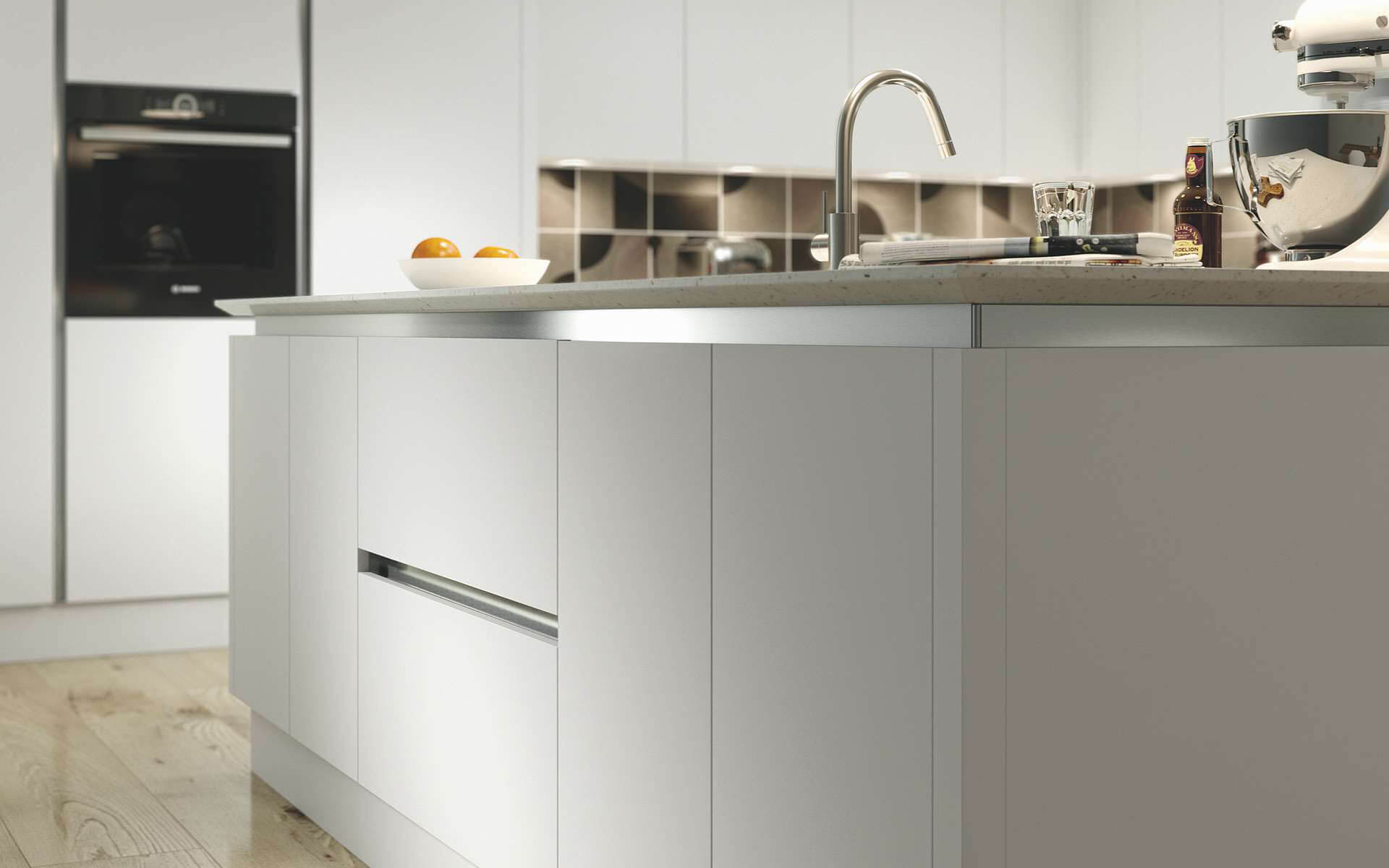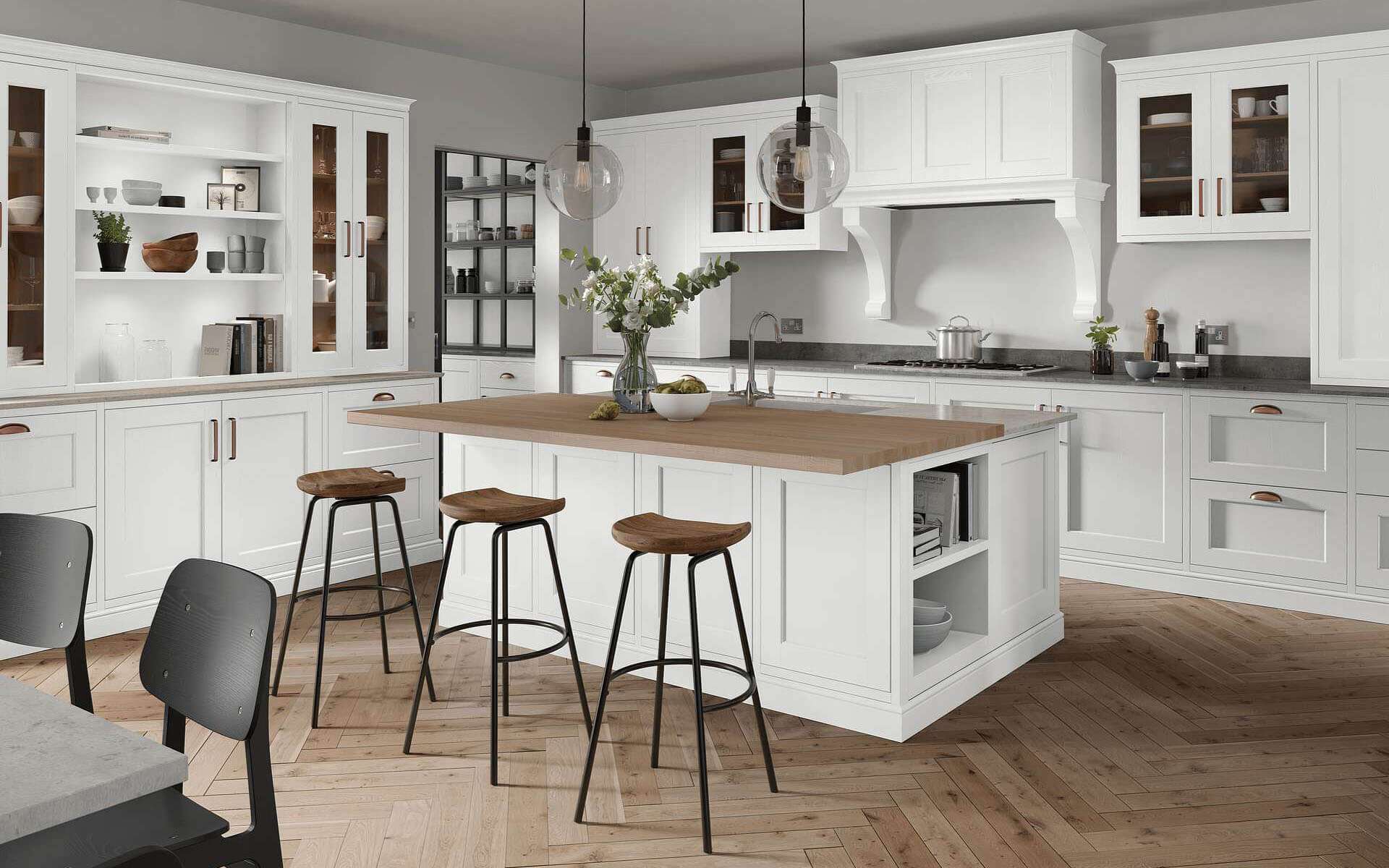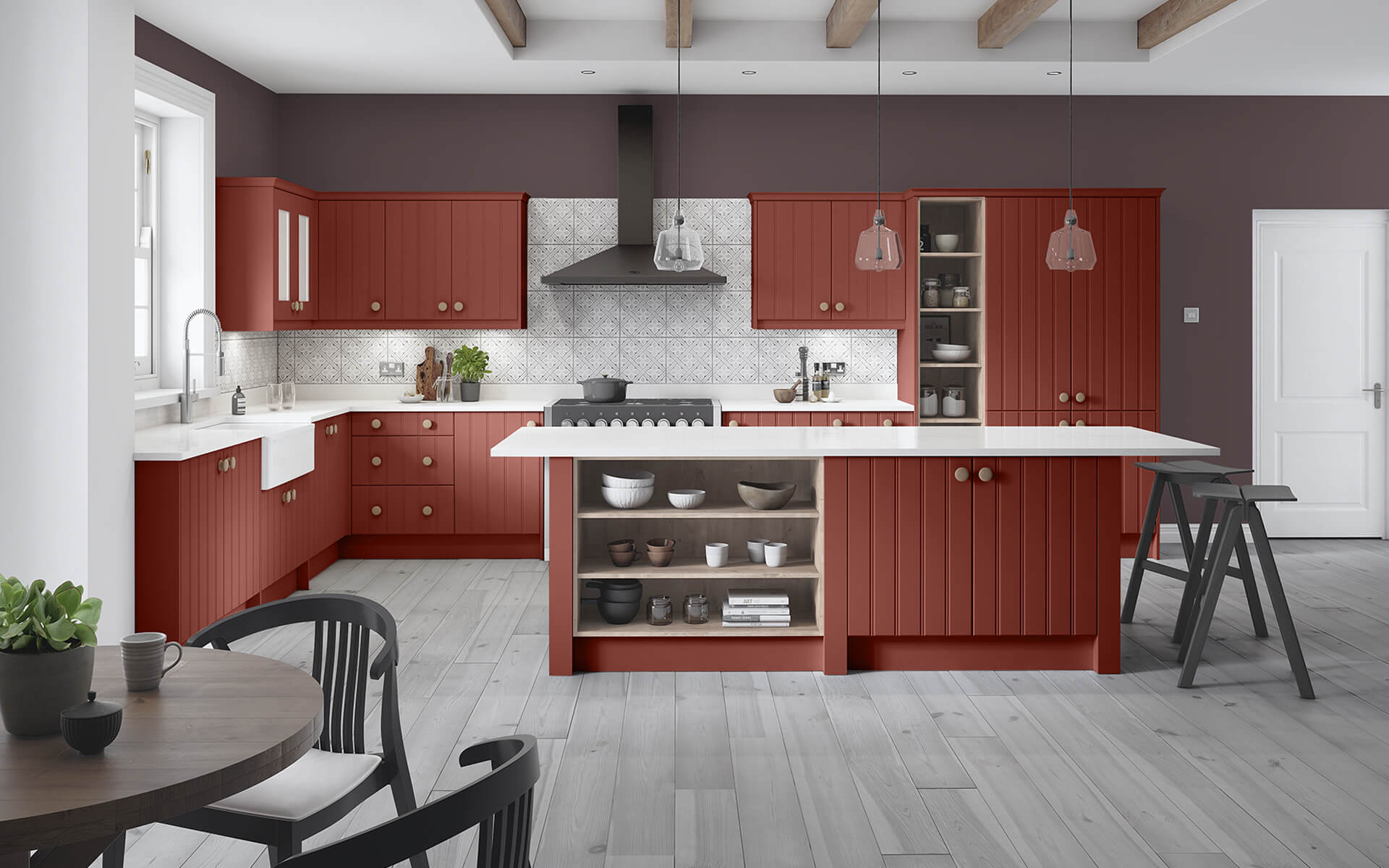Designing a kitchen island is a task that marries form and function. Creating a beautiful centrepiece that also serves a practical purpose.
One of the key aspects to consider when embarking on this endeavour is the size of the island, which significantly impacts the overall layout of your kitchen. An island that is proportioned well can enhance the flow of your space, making it a joy to cook, dine, and entertain.
Conversely, an incorrectly sized island can disrupt the kitchen’s functionality, turning what should be the heart of your home into a cumbersome obstacle.
The right size of the island is often dictated by the available space, but it's also influenced by your personal needs and preferences. It should provide enough room to manoeuvre comfortably, enough space for meal preparation, and the right amount of seating for family and guests.
A well-designed island can also offer additional storage, a breakfast bar, and a statement piece that elevates the overall aesthetic of your kitchen.
This blog post aims to guide you through the critical considerations for designing your perfect kitchen island, focusing on size and seating arrangements.
We will delve into the various kitchen island size guidelines, explore different island design ideas, and discuss the importance of selecting the right seating to ensure your kitchen is as functional as it is stylish. Through a thoughtful approach to the size and seating of your kitchen island, you can create a space that is both beautiful and perfectly suited to your lifestyle.
Understanding the Size of Your Kitchen Island
When embarking on the journey to design your kitchen island, one of the first steps is to understand the size guidelines that professionals in the field adhere to. The size of your island should not only cater to your personal needs but also harmonise with the overall layout and size of your kitchen.
The average size of a kitchen island is about 3 by 6.5 feet, according to the National Kitchen and Bath Association. However, the dimensions can vary significantly based on the available space and the functionalities you want to include. A standard kitchen island dimensions often fall within the range of 24 to 48 inches in width and 48 to 108 inches in length.
Whether you are designing a new kitchen or renovating an existing one, it's crucial to consider the space you have. If you have a small kitchen, a compact island with a streamlined design can be a smart choice, while those with a larger kitchen have the liberty to explore larger island designs.
Adequate space around the island is just as important as the island's size itself. It's recommended to have at least 42 to 48 inches of clear space around the island to ensure free movement and a comfortable working and seating area. This space allows for the opening of appliances, drawers, and ensures that the traffic flow around the island is unobstructed.

Kitchen Island in True Handleless with Shark Nose Worktop
The size of your large kitchen island will also influence the amount of counter space you have, which is crucial for meal prep, dining, and possibly housing appliances. It's essential to strike a balance between having enough room and counter space without overwhelming the rest of the kitchen with an oversized island.
The concept of the kitchen triangle - the optimal arrangement between the stove, sink, and refrigerator - also plays a part in determining the size and placement of your island. Ensuring that the island fits well within this triangle will contribute to the kitchen's overall functionality and ease of movement.
In the next section, we will explore various kitchen island ideas that can help you visualise and plan the perfect island for your kitchen, keeping the size guidelines and your personal preferences in mind.
"At Better Kitchens, we believe the heart of every home beats at the kitchen island. It's not just about size, but creating a harmonious blend of function and style. Let's design an island that makes your heart sing!"
Designing Your Kitchen Island: From Dimensions to Ideas
Now that you have a grasp on the size guidelines, it's time to dive into the creative process of designing your kitchen island. The dimensions of your island including its standard height, width, and length are the foundational aspects that will influence its functionality and aesthetics. However, the design process extends beyond mere measurements. It encapsulates a myriad of ideas and design elements that can transform your kitchen into a unique and personalised space.
A well-designed island can serve multiple purposes - from a prep station to a dining area, and even a storage unit. The possibilities are endless, and the design you choose should resonate with your lifestyle and the overall theme of your kitchen.
If you prefer a minimalist approach, a sleek, streamlined island with a modern finish may appeal to you. For those who lean towards a traditional aesthetic, an island with ornate detailing and a classic touch could be more appealing. There are also trendy designs like waterfall countertops, industrial styles, or islands with built-in appliances and smart storage solutions.
The shape of your island also plays a crucial role. While rectangular islands are common, you might want to consider other shapes like a square island or a circular or oval island, which might better suit your space and design preference.
Adequate, ample, and extra space around your island is essential to ensure it complements rather than disrupts the flow of your kitchen. Too much space could make your kitchen feel sparse, while too little space can make it feel cramped.
The concept of open space is also vital as it creates a breathable layout, giving your kitchen a spacious and airy feel. It also facilitates easy movement and interaction, making your kitchen a comfortable place to cook, dine, and socialise.
As you explore various design ideas, consider consulting with a professional kitchen designer. They have the expertise to help you navigate the design process, ensuring that the size, style, and functionality of your island are in perfect harmony with the rest of your kitchen.
In the upcoming section, we'll delve into the nuances of selecting the right kitchen island seating arrangements to complement your island design and ensure a comfortable and functional dining experience.
Seating Space and Arrangements

White Traditional Kitchen Island with Seating
A well-designed kitchen island is not just about aesthetics or meal preparation—it's also a social hub where family and friends can gather. The seating space and arrangements are critical to ensuring your kitchen island is welcoming and comfortable. Here’s how you can optimise the seating area of your kitchen island:
- Selecting the Right Bar Stools: Choosing the right kitchen bar stools is crucial for creating a comfortable seating area. The height of your bar stools should correspond with the height of your island to ensure a comfortable seating position. Additionally, consider the width of the stool to ensure there’s enough room for everyone to sit comfortably without feeling cramped.
- Seating Space: The amount of seating space and how much overhang you provide will largely depend on the size of your island. A good rule of thumb is to allocate at least 24 inches of width per person. This will ensure everyone has enough room to eat comfortably.
- Counter Space: Having ample counter space next to the seating area is vital for a comfortable dining experience. It provides room for food preparation, drinks, and elbows, ensuring your family and guests can dine in comfort.
- Spacing Around the Island: It’s important to leave enough room around the island for people to move comfortably. A minimum of 36 to 48 inches of space around the island is recommended to allow for easy movement and to accommodate the opening of nearby appliances and kitchen cabinets.
- Incorporating a Breakfast Bar: If your kitchen layout allows, incorporating a breakfast bar into your island design can provide an informal dining area that’s perfect for quick meals, especially during the busy morning rush.
- Accessibility: Ensure that the seating area is easily accessible and doesn’t obstruct the workflow in the kitchen. The seating should be arranged in a way that allows for easy movement and interaction while also adhering to the safety standards, especially when the kitchen is in use.
In the next section, we will explore how you can maximise storage solutions and maintain an open space concept, ensuring your kitchen island is not only beautiful but also highly functional and organised.
Storage Solutions and Open Space
A well-thought-out kitchen island can significantly contribute to the overall storage solutions and open space in your kitchen, making it a functional and pleasant space to work and socialise in. Here's how you can achieve that balance:
- Integrated Storage Solutions: Utilising the space within your island for storage can be a game-changer, especially in a kitchen where storage is at a premium. Incorporate drawers, shelves, and cabinets to house your pots, pans, utensils, and other kitchen essentials. Consider including specialised storage solutions like spice racks, wine racks, or pull-out trash bins for added convenience.
- Open Shelving: Open shelving is a great way to keep your frequently used items handy while also adding a visual element to your island. It creates a more airy feel and can be a great way to display your beautiful cookware or dishware.
- Adequate Open Space: Maintaining a sense of openness around your island is crucial to avoid a cramped or cluttered feel. Ensure there's enough room to move around comfortably, and consider how the island integrates with the rest of your kitchen layout to maintain a fluid, open concept.
- Too Much vs. Too Little Space: Striking the right balance between having too much space or too little space around your island is key. Too much space can make your kitchen feel disconnected, while too little space can hinder movement and functionality.
- The Flow of Traffic: Ensure that the placement of your island allows for a good flow of traffic, especially during busy cooking and dining times. The positioning of the island should complement the overall workflow of the kitchen, allowing for easy movement between different work zones.
- Multi-functional Islands: Consider designing your island to serve multiple purposes. Besides storage, it could serve as a dining area, a prep station, or even a place for kids to do homework. The more functions your island can serve, the more you can maximise your kitchen space.
In the next section, we will delve into the final considerations for finding the perfect island for your kitchen, tying together all the aspects discussed to help you make an informed decision.
Finding the Perfect Island for Your Kitchen

Vintage Rose Kitchen with Island and Seating Feature
Having traversed through the realms of size, design, seating arrangements, and storage solutions, you are now armed with a wealth of information to make an informed decision. Finding the perfect island for your kitchen is a culmination of these factors, tailored to your personal preferences and the unique layout of your kitchen. Here are some final considerations to help you on this journey:
- Professional Consultation: Engaging a professional kitchen designer could provide invaluable insights. They can help harmonise your desires with practical solutions, ensuring the size, style, and functionality of your island are in perfect harmony with the rest of your kitchen.
- Best Size for Your Needs: Reflect on the discussions about the best kitchen island size and ensure the dimensions of your chosen island complement your kitchen’s size and your lifestyle.
- Versatile Design Choices: Opt for designs that offer a blend of functionality and aesthetic appeal. The best kitchen islands are those that can adapt to your needs, whether it's extra seating, additional storage, or a flexible work surface.
- Future-Proofing: Consider how your needs might evolve over time. A well-designed island can adapt to changing circumstances, whether it’s a growing family or evolving culinary interests.
- Budget Considerations: Keep in mind the budget as kitchen islands can range from simple, cost-effective solutions to high-end, custom-designed pieces. It's essential to find a balance between your desires and your budgetary constraints.
- Personal Touch: Lastly, infuse your personal touch into the design. Whether it's a particular material, colour scheme, or unique feature, your kitchen island should reflect your personality and make a statement in your home.
In conclusion, designing the perfect kitchen island requires a blend of careful consideration, professional insight, and personal creativity. Reflect on the tips and guidelines shared in this blog as you embark on the exciting journey of creating a kitchen island that is both beautiful and perfectly suited to your lifestyle.
Top Tips for Your Kitchen Island Design
Refining your kitchen island's design? Here are three indispensable tips from Better Kitchens to ensure functionality meets style.
- Function Over Form: Before choosing your island's look, ponder its primary purpose. Is it for preparation, dining, or a mix? Design it with this foremost in mind.
- Space Sensibility: Ensure you've got ample space around the island for easy movement and the opening of appliance doors. Even the most striking island can become a hindrance if it's too large for the room.
- Smart Seating: When incorporating seats, keep comfort and ease of access at the forefront. Think about leg space, the depth of the overhang, and the island's height for a snug dining spot.
Conclusion
Designing the perfect kitchen island is a harmonious blend of form and function. Through this comprehensive guide, we've traversed the critical aspects of size, design, seating arrangements, storage solutions, and personal considerations that come into play. Each facet is a piece of the puzzle that, when carefully considered, brings you one step closer to realising the perfect kitchen island tailored to your needs and desires.
The journey may require meticulous planning, perhaps consultation with a professional kitchen designer, and a dash of creativity. Yet, the reward is a well-designed kitchen island that not only enhances the aesthetic appeal of your kitchen but also elevates its functionality, making your kitchen the heart of your home.
As you embark on this exciting endeavour, reflect on the insights shared in this guide, keep an open mind to a new good idea, and remember to infuse your personal touch into the design. After all, your kitchen is a reflection of your lifestyle, and its design should resonate with your unique taste and personality.
With a well-thought-out plan and a clear vision, your dream kitchen island is well within reach. May your kitchen island not only meet your practical needs but also bring joy, comfort, and a sense of fulfilment as it becomes a cherished centrepiece in your home.
Ready to transform your kitchen space? Don't leave your island dreams on the back burner. Connect with our experts at Better Kitchens today and let's bring your vision to life! Click here to start your journey.
